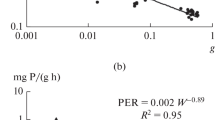Abstract
The anaerobic metabolism of the intertidal polychaete Scoloplos armiger, its recovery from anaerobiosis and the importance of anaerobic energy production during low tide in the field were investigated. Under anaerobic conditions S. armiger produces energy in the same manner as Arenicola marina, a prototype of an euryoxic invertebrate from the intertidal. Energy is produced from the phosphagen stores and from the breakdown of glycogen to volatile fatty acids, mainly propionate and to a lesser extend acetate. However, S. armiger cannot reduce its energy demand to the same degree as A. marina. This and the relatively small pool of glycogen may be the reason for its only moderate resistance to anoxia. The recovery from anaerobiosis proceeds in S. armiger significantly slower than in A. marina. S. armiger is able to maintain a fully aerobic metabolism down to a PwO 2of ca. 20 torr and even at a PwO 2of ≤10 torr a partly aerobic metabolism was retained. In the field during low tide S. armiger ascends into the oxidative layer, where it is able to maintain an aerobic metabolism even at parts without remaining puddels on the surface.
Similar content being viewed by others
Literature cited
Alphei, J. (1987). Verteilung, Mortalität und Feindspektrum juveniler Scoloplos armiger (Polychaeta) im Sandwatt der Nordsee. Diplom-Arbeit, Universität Göttingen, Göttingen FRG
Bergmeyer, H. U. (ed.) (1974). Methoden der enzymatischen Analyse. 3. Aufl. Verlag Chemie, Weinheim
Boyden, C. R. (1972) The behaviour, survival and respiration of the cockles Cerastoderma edule and C. glaucum in air. J. mar. biol. Ass. U.K. 43:697–712
Felbeck, H. (1980) Investigations on the role of the amino acids in anaerobic metabolism of the lugworm Arenicola marina L. J. comp. Physiol. 137:183–192
Gäde, G., Carlson, K.-H. (1984). Purification and characterisation of octopine dehydrogenase from the marine nemertan Cerebratulus lacteus (Anopla: Heteronemerta): comparison with scallop octopine dehydrogenase. Mar. Biol. 79:39–45
Grieshaber, M. K. (1982). Metabolic regulation of energy metabolism. In: Addink, A. D. F. and Spong, N. (eds.). Exogenous and endogenous influences on metabolic and neural control. Pergamon Press, Oxford, p. 225–242
Kluytmans, J.H. F. M., Veenhof, P. R., de Zwaan, A. (1975). Anaerobic production of volatile fatty acids in the sea mussel Mytilus edulis L.. J. comp. Physiol. 104:71–78
Pionetti, J. M., Toulmond, A. (1980). Tide-related changes in volatile fatty acids in the blood of the lugworm, Arenicola marina (L.) Can. J. Zool. 58:1723–1727
Pförtner, H. O., Surholt, B., Grieshaber, M. (1979). Recovery from anaerobiosis of the lugworm, Arenicola marina L.: Changes of metabolite concentrations in the body-wall musculature. J. comp. Physiol. 133:227–231
Reise, K. (1979). Spatial configurations generated by motile benthic polychaetes. Helgoländer wiss. Meeresunters. 32:55–72
Reise, K., Ax, P. (1979). A meiofaunal “Thiobios” limited to the anaerobic sulfide system of marine sand does not exist. Mar. Biol. 54:225–237
Schöttler, U. (1979). Investigations of the anaerobic metabolism of the polychaete worm Nereis diversicolor M., J. comp. Physiol. 125:185–189
Schöttler, U. (1982a). Vergleichende Untersuchungen zum Anaerobiosestoffwechsel von Polychaeten. Habilitationsschrift, University of Münster, Münster, FRG
Schöttler, U. (1982b). An investigation on the anaerobic metabolism in Nephtys hombergii (Annelida, Polychaeta). Mar. Biol. 71:265–269
Schöttler, U., Schroff, G. (1976). Untersuchungen zum anaeroben Glykogen-Abbau bei Tubifex tubifex. J. Comp. Physiol. 108:243–254
Schöttler, U., Surholt, B., Zebe, E. (1984a) Anaerobic metabolism in Arenicola marina and Nereis diversicolor during low tide. Mar. Biol. 81:69–73
Schöttler, U., Wienhausen, G., Westermann J. (1984b) Anaerobic metabolism in the lugworm Arenicola marina: the transition from aerobic to anaerobic metabolism. Comp. Biochem. Physiol. 79B:93–103
Siegmund, B., Grieshaber, M. K. (1983). Determination of mesoalanopine and D-strombine by high pressure liquid chromatography in extracts from marine invertebrates. Hoppe-Seyler's Z. physiol. Chem. 358:1455–1461
Zwaan, A. de (1983). Carbohydrate catabolism in bivalves. In: Hochachka, P. W. (ed.), The mollusca, Vol. 1. Academic Press, London/New York, p. 137–175
Zwaan, A. de, van den Thillart, G. (1985). Low and high power output modes of anaerobic metabolism: invertebrate and vertebrate strategies. In: Gilles, R. (ed.), Circulation, respiration and metabolism. Springer, Heidelberg p. 166–192
Zwaan, A. de, Zurburg, W. (1981). The formation of strombine in the adductor muscle of the sea mussel Mytilus edulis L.. Mar. Biol. Lett. 2:179–192
Zebe, E., Schöttler, U. (1986) Vergleichende Untersuchungen zur umweltbedingten Anaerobiose. Zool. Beitr. N. F. 30:125–140
Author information
Authors and Affiliations
Additional information
Communicated by O. Kinne, Oldendorf/Luhe
Rights and permissions
About this article
Cite this article
Schöttler, U., Grieshaber, M. Adaptation of the polychaete worm Scoloplos armiger to hypoxic conditions. Mar. Biol. 99, 215–222 (1988). https://doi.org/10.1007/BF00391983
Accepted:
Issue Date:
DOI: https://doi.org/10.1007/BF00391983




